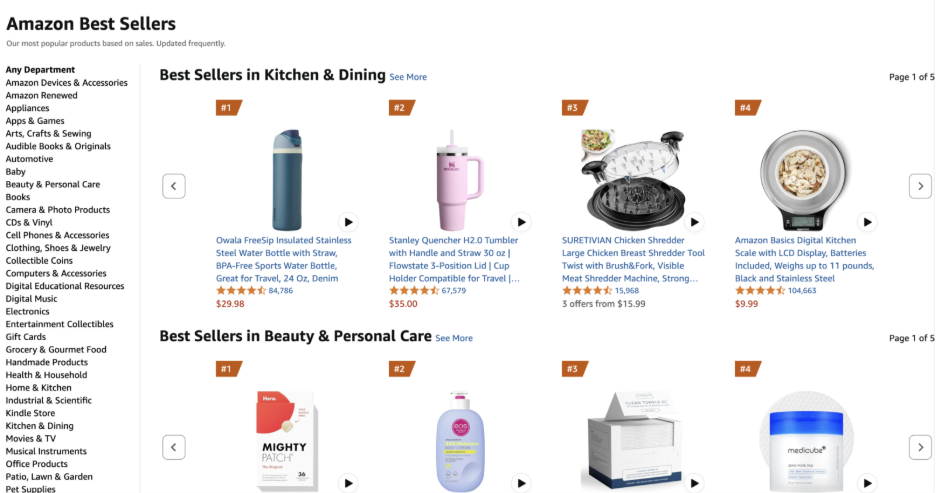

Have you ever wondered why most of your sales often come from just a handful of products, or why a small group of customers seem to make up most of your repeat orders?
In 1897, Vilfredo Pareto noticed something curious in his garden: a small share of pea pods produced most of the peas. He looked further and found the same pattern in land ownership and wealth. Economists later called it the Pareto Principle; a small portion often drives the majority of results.
A century later, you can see the same in e-commerce:
Spotting that pattern is easy. Acting on it? That’s where most merchants stumble.
Enter the Bullseye Framework, originally built for growth teams picking marketing channels, but just as useful for merchants deciding where to place effort. It works in three rings:
If Pareto shows you where the weight is, Bullseye tells you when to commit, where to focus, and how to keep testing without getting stuck on yesterday’s winners.
Take July 2025’s mega-sale week: U.S. shoppers spent $24.1B online, half of it on mobile, with Buy Now, Pay Later covering 8% of orders. If your top three products were both profit leaders and heavily bought on mobile or BNPL, that’s your signal. They belong in the bullseye center, fast PDPs, priority in checkout, and stock set aside.
But not every business looks the same. Electronics often see steady sales across categories, laptops, tablets, headphones. Here, your Bullseye isn’t just one hero, but a set of reliable performers you keep in the middle ring. Beauty industry, on the other hand, rotates fast: lip oils today, skin tints tomorrow. Your bullseye shifts every quarter.
Also, leaving too much in the center for too long. You can shrink variety, hurt SEO, or miss the next breakout. Like Pareto’s garden, the best yield changes with the season. The merchant’s job is to keep checking the patch, spot what’s thriving now, and decide which products deserve the bullseye push this quarter.
In most supermarkets, essentials like milk, bread, vegetables are mostly placed at the back. To reach them, you pass shelves filled with snacks, chocolates, and candles. The store isn’t counting on milk for profit; it’s the extras along the way that bring in most of the margin.
That’s Pareto in action: a small portion of products get shoppers in the door, while the rest make the money.
The same dynamic plays out mostly everywhere in commerce.
Take Costco’s $4.99 rotisserie chicken. It’s not a margin maker, even Costco admits they lose money on it. But it’s the hook that gets people through the door, and once they’re in? They’re filling carts with wine, snacks, patio furniture and whatever “feels like it”. One SKU drives disproportionate behavior.
Amazon’s Best Sellers:
Take Amazon’s Best Sellers. Out of millions of listings (over 600 million in 2024), a handful dominate visibility, cart adds, and reviews. Sellers who break into that tier often see their growth curve bend overnight.

Look at Stanley. Their Quencher tumbler has consistently held a spot in Amazon’s top 2. It’s the anchor that pulls shoppers in. Once people land on Stanley’s page for that viral tumbler, many go on to buy other products in the lineup, water bottles, lunch boxes, coffee and tea mugs. One hero product draws attention, and the rest of the catalog benefits from the spillover.
And then there’s Sephora. Trends in beauty rotate faster than playlists, lip oils one quarter, skin tints the next. If they only doubled down on last season’s winners, they’d miss the next viral wave. That’s why they lean on rotating “Favorites” kits and sample perks in their Beauty Insider program. Customers think it’s just a treat; Sephora uses it as a lab to see which products deserve the bullseye focus.
The point?
It’s not a one-size-fits-all law. Some businesses (like Costco) skew heavily to a “vital few,” while others (like Sephora) see their 20% change every season. The trick isn’t to crown winners forever; it’s to keep checking the patch and pour more water where the pods are thriving this season.
Let’s say you run a furniture store. You’ve got everything, sofas, dining sets, coffee tables, rugs, lamps, and wall art. On the surface, it all feels equally important. But when you look closely, the 80/20 pattern always sneaks in. Here’s how to spot it:
Run a 90-day sales report. Out of 200 products, you might notice that a handful of them, say a sectional sofa, a mid-range dining set, and a best-selling mattress, bring in more than half of your revenue, while the other 190 items together make up the remaining 40%.
The exact split doesn’t always have to be 80/20; sometimes it’s 90/10, 70/30, or another mix. The point isn’t the ratio itself; it’s seeing that a smaller share often carries more weight than the rest.
Spotting those anchors is only step one; the question is how to act on them without ignoring the rest. That’s where the Bullseye rings help:
Some products become long-term anchors, like your sectional sofa or mattress, they consistently deliver revenue and rarely drop out of the top tier. Others, like accent tables, seasonal décor, or trendy chair designs can spike in popularity for a few months and then fade as customer tastes shift.
That’s why it helps to review your trending products regularly. One quarter, your sofas and mattresses might make up 60% of revenue; the next quarter, a new coffee table line could start climbing into that group. The goal isn’t to assume your winners never change, but to recognize when something new is moving up and give it the chance to become part of the bullseye center.
So, what happens when you move from theory to dashboard reality? Identifying your “vital few” and applying the Bullseye approach can transform how you merchandize, market, and retain.
1. Smarter inventory planning: As said earlier, rather than spreading stock across 200 products, focus on those that truly move the needle. The less is the new more.
Hey, FYI, we broke this down in detail in 15% cost cuts, 3X faster cash flow: how supply chain advantages build great businesses. Worth a read if you want to see how inventory decisions ripple through your cash flow.
For example, Best Buy’s core categories (TVs, laptops, mobile devices) continue to contribute a major portion of their revenue and customer foot traffic (FYI that doesn’t mean to ignore others). It simply shows that prioritizing anchors helps improve availability and operational efficiency while the rest supports the overall customer journey.
And when those anchors are in high demand, even small shipping hiccups can ripple through revenue. That’s where coverage for transit issues helps.
With SureBright: AI powered platform protection merchants can safeguard high-value items, a damaged laptop or stolen TV doesn’t turn a strong seller into a costly headache.
See how protection turns risky orders into repeat customers, we’ll help you map it.
2. More efficient marketing spend: Marketing every product equally doesn’t usually help you but directing spend around proven winners does. Allbirds (an American public benefit corporation known for its sustainable footwear and apparel) became a million-dollar DTC brand by building around its hero product, the Wool Runner. Though they’ve since diversified, that flagship style was foundational to their early growth and recognition.
3. Clearer customer segmentation: Pareto is true for customers too: often 20% of buyers drive most repeat purchases. Bullseye offers a way to act like early benefits and drops go in the center with perks and exclusives, while new or occasional shoppers sit in the outer ring for testing.
4. Stronger retention and repeat purchases: Retention thrives on the balance between consistency and discovery.
Starbucks is a classic case: core menu items like lattes and cold brew are always available, while seasonal drinks like the Pumpkin Spice Latte rotate in to spark excitement. That mix reflects both Pareto (steady anchors) and Bullseye (rotating tests) in action.
That balance is what makes the framework so appealing, yet it’s important to remember that not every business will see patterns this clearly.
Pareto × Bullseye can be a powerful lens for planning and decision-making, but like any framework, it has its limits. It won’t always fit every type of business, and relying on it too rigidly can create blind spots. Knowing where it falls short is just as useful as knowing where it shines.
Finally,
Pareto found his insight in pea pods. Today, merchants find it in dashboards.
Of course, it’s not a silver bullet. Some businesses will see clear anchors; others will deal with shifting sands where their vital few change every season. The real skill is balance, knowing when to double down on what’s proven, and when to keep the door open for what’s emerging.
As Bruce Lee once said: “Be water, my friend.”
Flow around the rocks but also know where the current is strongest. For merchants, that means running the numbers, spotting your “the products”, and then deciding which deserves the bullseye this season, without forgetting that next season’s winners may already be sprouting.
The frameworks won’t run your business for you, but they’ll give you the lens and compass to make sharper calls. And in e-commerce, where trends shift faster than TikTok scrolls, that balance can be the difference between chasing demand and owning it.